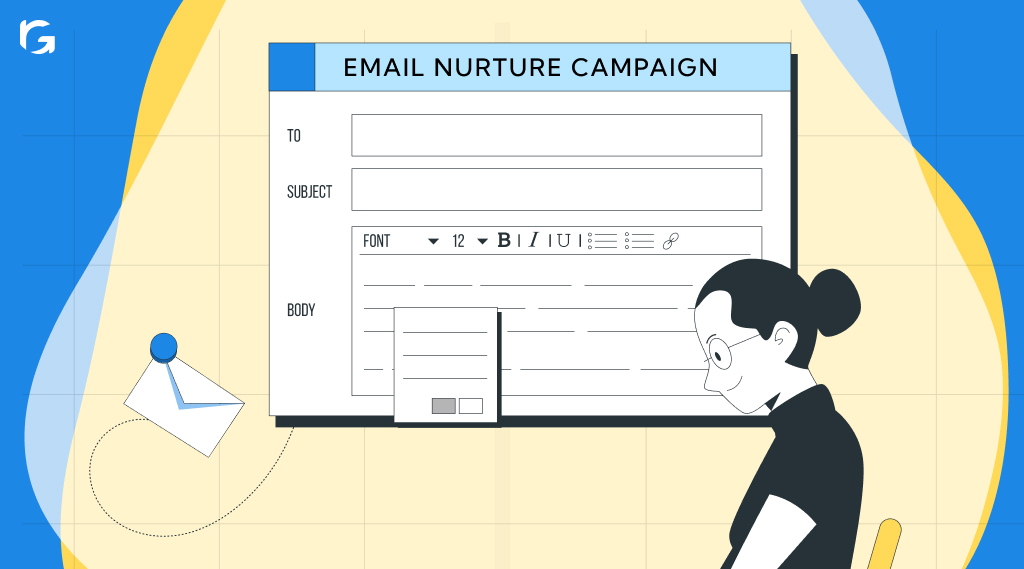Introduction
Despite common misconceptions, email marketing is thriving and continues to be a powerful tool. As B2B marketing leaders, we see consistent engagement, with open rates averaging 46 to 50%. This proves that email marketing continues to be relevant.
So, what are email nurture campaigns, and how can they help you achieve significant results for your business?
Consider email nurture campaigns an essential element of your outbound marketing efforts. These automated email series are designed to build relationships, educate recipients, and guide them through the buyer’s journey. They are all about engaging with prospects and guiding them through the sales funnel using a series of automated and personalized emails sent over a set period.
The main goal here is to build relationships with your leads. You do this by providing valuable content tailored to their interests and needs, gradually nudging them towards purchasing or taking other desired actions. This approach has several benefits:
- Tailored content: Deliver personalized messages that resonate with your audience.
- Progressive engagement: Gradually increase interaction with your prospects.
- Relationship building: Foster trust and loyalty with your audience.
- Data-driven insights: Gain valuable data to refine your marketing strategies.
- Cost-effectiveness: Achieve high ROI with relatively low costs.
- Increased conversion rates: Convert more prospects into customers.
- Improved customer retention: Keep your existing customers engaged and satisfied.
Let’s explore the potential of email nurture campaigns together.
Types of email nurturing campaigns
For effective marketing, forming strong connections with prospects and customers is crucial. Email nurturing campaigns are designed to do just that.
These campaigns use targeted and personalized emails to guide your audience through their buyer’s journey, delivering relevant content at each stage.
Let’s explore the different types of email nurturing campaigns and how they can help you achieve your marketing goals.
- Welcome sequence
- Educational sequence
- Product onboarding
- Re-engagement campaigns
- Upsell/Cross-sell campaigns
- Customer success campaigns
- Event or Webinar campaigns
1. Welcome sequence
First impressions matter. A well-crafted welcome series sets the tone for the rest of your relationship with a new subscriber. Typically, this series consists of two to four emails. The goal is to introduce your brand, highlight key offerings, and encourage further engagement.
You might start with a warm welcome email explaining your brand’s story and another highlighting your most popular products or services.
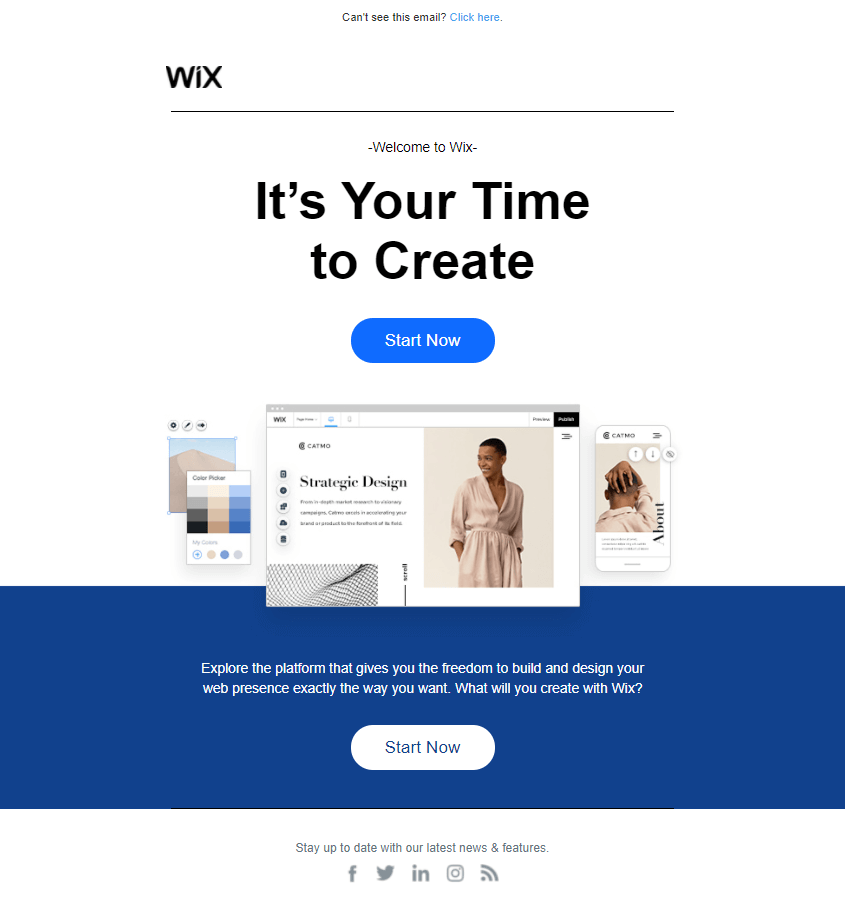
Let’s look at how Wix does this effectively. When someone signs up with Wix, they receive a welcome email titled “Welcome to Wix.” This email engages and focuses on the platform’s flexibility, encouraging users to start creating their websites immediately. It’s designed to make new users feel excited and ready to explore.
The follow-up emails in Wix’s series provide helpful tips, showcase various features, and offer support resources. This approach introduces Wix’s capabilities and builds a connection with new users, making them feel supported and encouraged to use the platform.
This thoughtful welcome sequence by Wix demonstrates how a series of well-timed, informative emails can set a positive tone, build relationships, and drive user engagement right from the start.
2. Educational sequence
These campaigns provide valuable information and insights to educate leads about your products or services. Whether through blog posts, case studies, or how-to guides, the goal is to establish your authority in the industry and help prospects make informed decisions.
A B2B company might send emails that include industry reports, whitepapers, and expert tips on best practices.
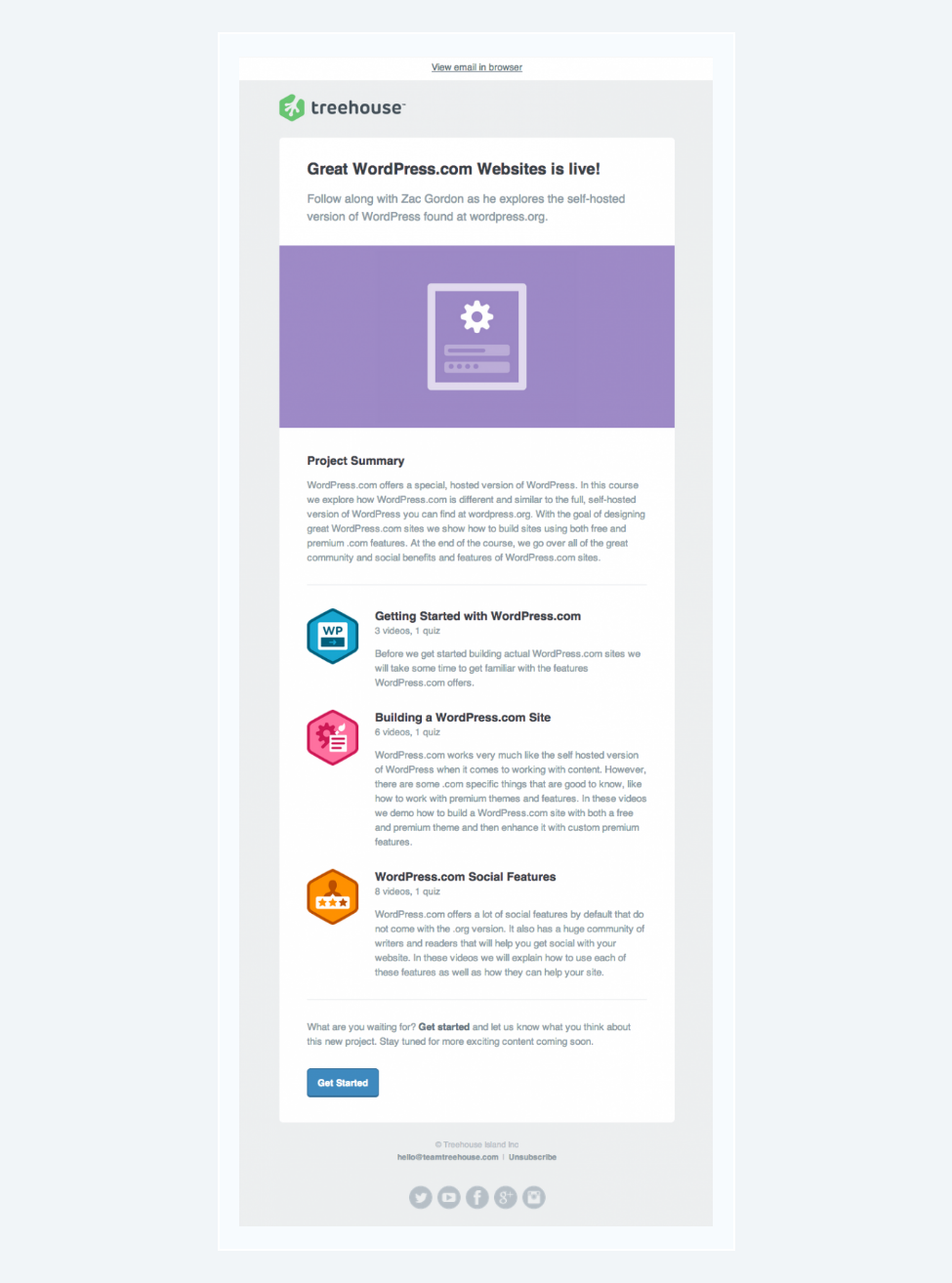
Let’s look at how Treehouse, an online learning platform, does this effectively. Treehouse provides programming and coding courses and uses educational email sequences to convey the value of its offerings to subscribers. For example, in their email sequence for a WordPress course, they provide users with a detailed project description and an overview of the course sections.
This approach helps potential customers understand what they will gain from the course and how it will benefit them. The emails are designed to be visually appealing and informative, ensuring that recipients grasp the total value of the course. By doing this, Treehouse educates its leads, builds trust, and encourages further engagement with its content.
3. Product onboarding
Onboarding campaigns are vital for SaaS companies and other subscription-based businesses. They assist new users in navigating the initial setup process and highlight the benefits of your product. Addressing common pain points and highlighting key features can increase user retention and satisfaction.
You might send a step-by-step guide to setting up your software, followed by tips and tricks for getting the most out of it.
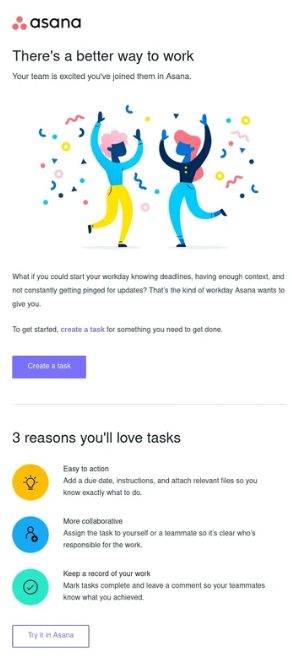
Let’s see how Asana, a work management platform, effectively uses product onboarding emails. When new users sign up, Asana sends a welcome email confirming their account and introducing the product’s main capabilities. This email often includes a GIF showing tasks being completed on the Asana interface, giving new users a quick sense of achievement and ease of use.
Subsequent emails in Asana’s onboarding sequence offer step-by-step guides on setting up projects, tips for effective team collaboration, and best practices to get the most out of the platform. By providing this helpful, digestible information, Asana ensures new users feel supported and empowered to make the most of their tools right from the start.
This thoughtful approach to onboarding helps users quickly understand the platform’s value, leading to higher satisfaction and retention rates.
4. Re-engagement campaigns
Not all leads are ready to purchase immediately, and some may lose interest over time. Re-engagement campaigns aim to win back inactive subscribers by offering incentives, personalized recommendations, or simply reminding them of the value you provide.
Your company could offer a special discount or share new product updates to rekindle interest.
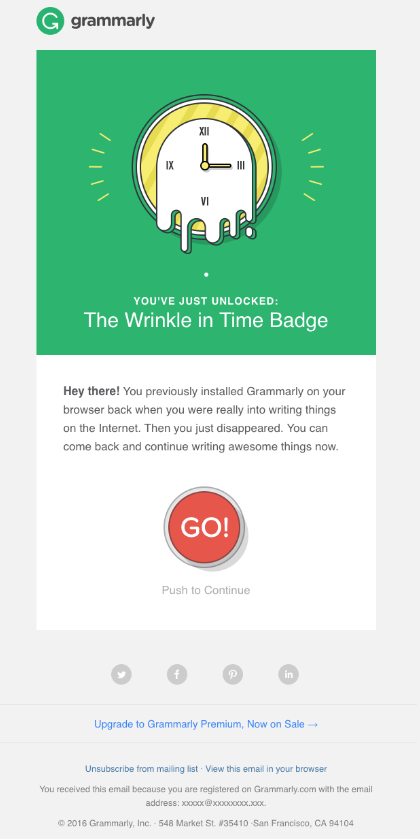
Grammarly, a popular writing assistant tool, effectively uses re-engagement emails to win back inactive users. Their campaign targets users who have not used the product in a while, using personalized statistics and helpful writing tips to reignite interest.
Re-engagement Email #1: Grammarly emails premium users who haven’t used the tool in the past week. This email includes personalized statistics showing the number of mistakes Grammarly helped correct and the time saved on proofreading. By highlighting these benefits, Grammarly reminds users of the tool’s value and encourages them to re-engage.
Re-engagement Email #2: For users who only use the free browser extension, Grammarly sends an email emphasizing what they might be missing by not fully utilizing the tool. The email mentions specific features and benefits they are missing out on, such as catching more mistakes and saving more time, which creates a sense of loss and prompts users to re-engage.
This approach, leveraging personalized content and clear calls to action, effectively reminds users of the value they can gain by returning to Grammarly, leading to higher re-engagement rates
5. Upsell or Cross-sell campaigns
Once a lead becomes a customer, the journey doesn’t end there. Upsell and cross-sell campaigns present additional products or upgrades based on the customer’s previous purchases, maximizing lifetime value and promoting loyalty.
If a customer buys a basic software package, you could email them about the benefits of upgrading to a premium version.
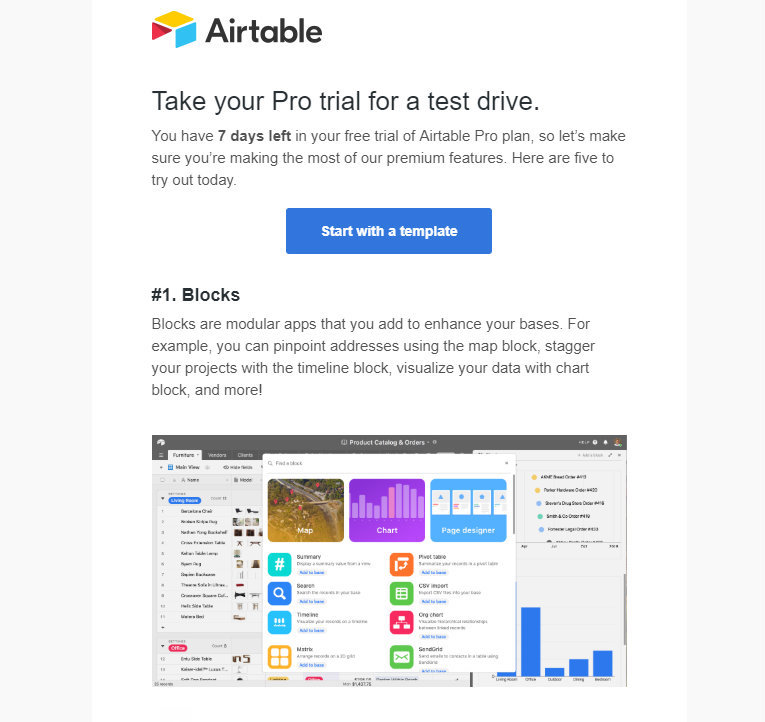
Airtable, a flexible database management tool, uses upsell and cross-sell strategies to enhance user experience and drive additional revenue. Here’s how they do it:
Airtable uses in-app messages and emails to upsell users from free or lower-tier plans to premium plans. For instance, when a user reaches the limit of their current plan, such as the number of records or attachments, Airtable triggers an in-app message suggesting an upgrade to a higher-tier plan. This message is often accompanied by an email highlighting the benefits of upgrading, such as increased storage, advanced collaboration features, and priority support.
By providing timely and relevant upsell and cross-sell prompts, Airtable successfully enhances user satisfaction and increases customers’ lifetime value.
6. Customer success campaigns
Customer success campaigns ensure that your customers get the most out of your product or service. These emails can include tips, tutorials, and best practices that help users maximize their investment.
You might send a monthly newsletter with success stories, advanced usage tips, and new feature announcements.
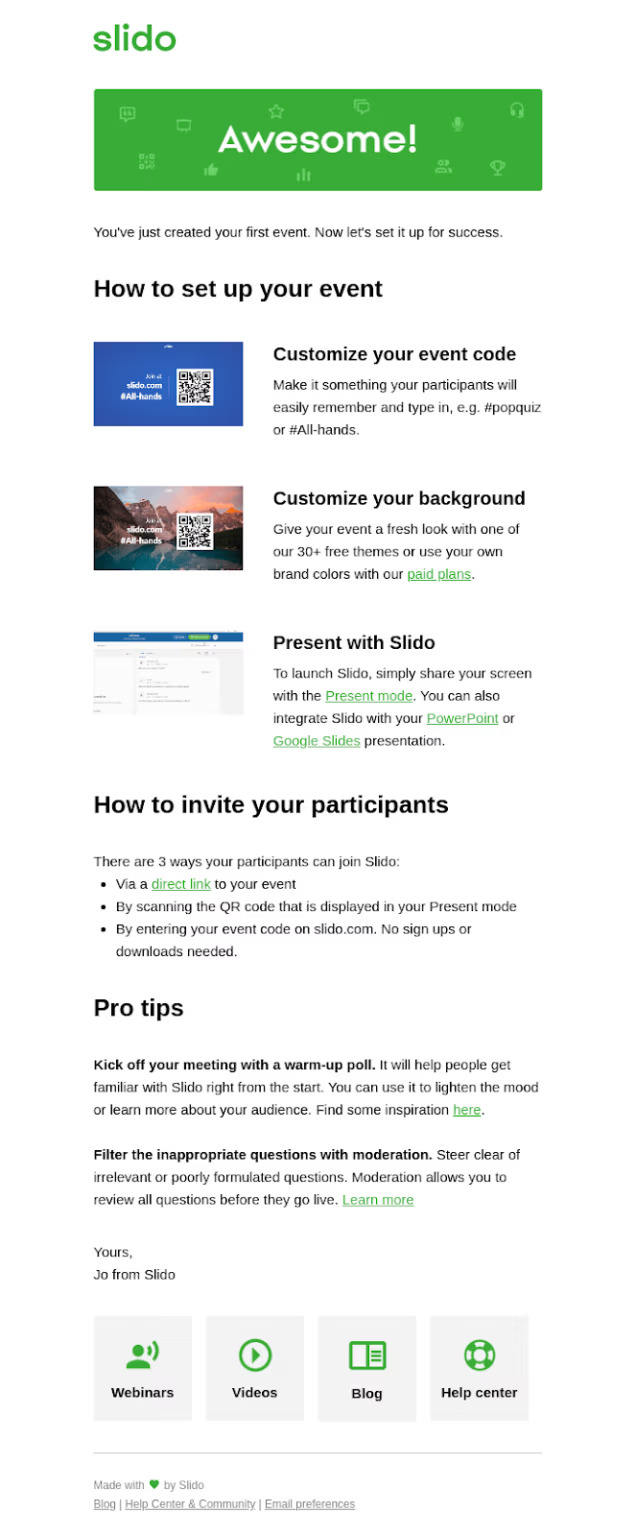
Slido, an audience interaction platform, effectively uses customer success campaigns to engage and support its users. Here’s how they do it:
Slido sends tutorials and best practices in its email campaigns. For example, it provides step-by-step guides on using live polls and Q&A sessions to enhance audience engagement during webinars and conferences. These resources empower users to make the most of Slido’s features, ensuring maximum value from the platform.
Whenever Slido rolls out new features, they inform users through dedicated emails. These announcements include detailed explanations and use cases, helping users quickly integrate new functionalities into their workflows.
By implementing these customer success campaigns, Slido ensures that its users are well-informed, engaged, and able to fully utilize the platform’s capabilities, leading to higher satisfaction and retention rates
7. Event or Webinar campaigns
Event or webinar campaigns are designed to drive attendance to your events. These emails should highlight the benefits of attending, include easy registration links, and send reminders as the event date approaches.
a B2B company might promote an upcoming industry webinar, sharing details on the topics covered and the expert speakers.
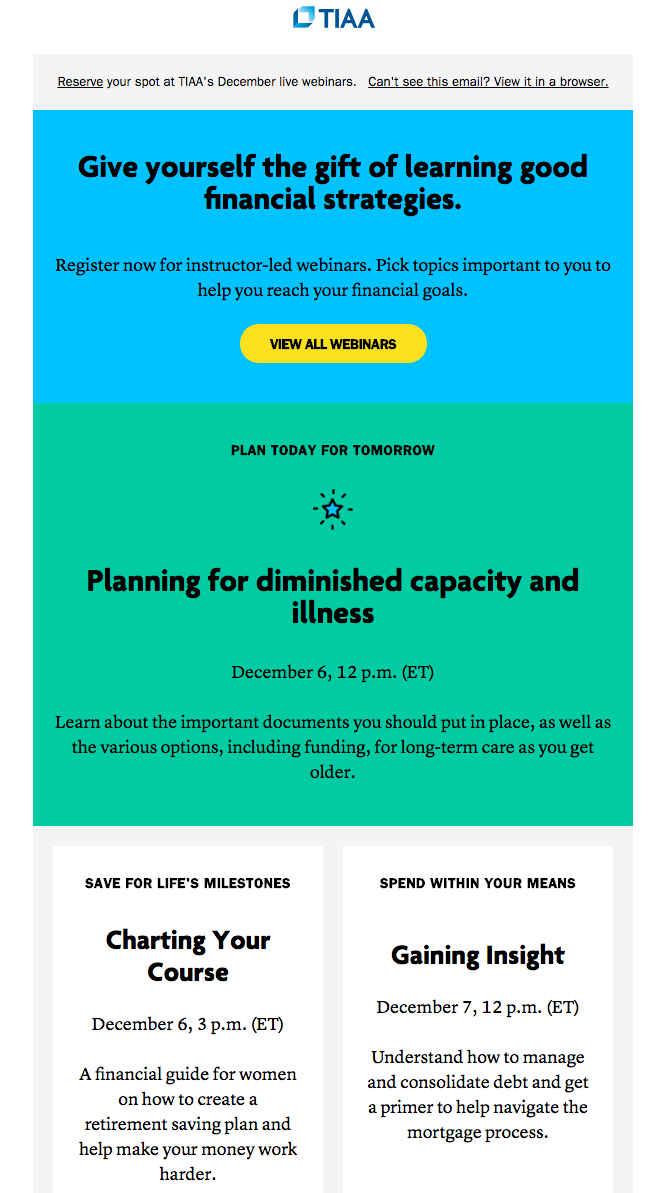
TIAA, a financial services organization, effectively uses email campaigns to promote its webinars. Here’s how they do it:
TIAA sends initial emails to announce upcoming webinars, such as “Maximize Your Health Savings Account” or “Strategies for Staying on Track” for retirement planning. These emails detail the topics covered and the benefits of attending and feature easy-to-click registration links, making it simple for recipients to sign up.
They also send reminder emails to registered participants. These emails ensure attendees don’t forget about the event and include all necessary details, such as the date, time, and access information.
By effectively utilizing promotional, reminder, and follow-up emails, TIAA drives significant attendance and engagement for its webinars, ensuring its audience gains valuable insights and continues interacting with its brand.
The following section will look into the best practices for lead nurturing emails.
Best practices for lead nurturing emails
With the right approach, lead nurturing emails can effectively guide potential customers through the buyer’s journey, from awareness to decision.
This section explores the best practices for crafting lead-nurturing emails that resonate with recipients. It ensures your messages capture attention, encourage engagement, and build trust over time:
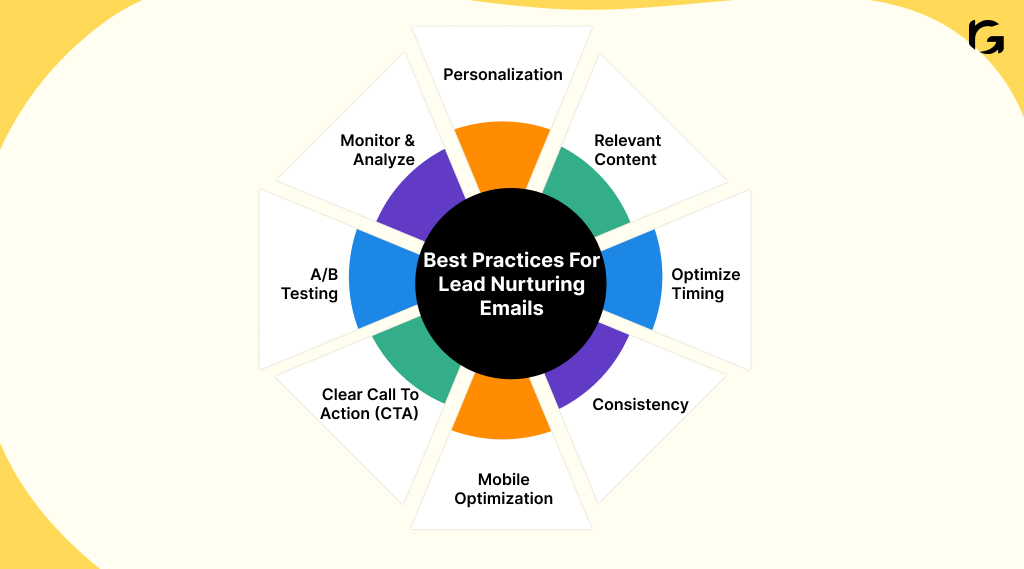
- Personalization
- Relevant content
- Optimize timing
- Consistency
- Mobile Optimization
- Clear call-to-action (CTA)
- A/B testing
- Monitor and analyze
Let us look into each of them in detail:
1. Personalization
People tend to have generic emails that won’t cut in a crowded inbox. Use segmentation and personalization to deliver targeted content that resonates with each subscriber’s interests, preferences, and behavior.
2. Relevant content
Keep your emails focused and relevant to the recipient’s stage in the buyer’s journey. Whether it’s introductory content for new leads or advanced tips for existing customers, the key is to deliver value with every message.
3. Optimize timing
Timing is everything when it comes to email engagement. Pay attention to factors like time zones, industry trends, and past engagement data to determine the optimal send time for your audience.
4. Consistency
While the frequency may vary depending on your industry and audience preferences, aim to maintain a consistent cadence with your email campaigns. Whether it’s weekly newsletters or monthly updates, regular communication helps keep your brand at the forefront of your mind.
5. Mobile optimization
With more users accessing emails on mobile devices than ever, ensuring your campaigns are mobile-friendly is essential. Optimize for smaller screens, use responsive design, and keep your copy concise for easy readability.
6. Clear call-to-action (CTA)
Every email should have a clear purpose and a compelling call to action that guides recipients toward the next step in their journey, whether visiting your website, downloading a resource, or purchasing.
7. A/B testing
Don’t rely on guesswork when optimizing your campaigns. Through A/B testing, experiment with different subject lines, content formats, and CTAs to identify what resonates best with your audience.
8. Monitor and analyze
Keep a close eye on key metrics such as open rates, click-through rates, and conversion rates to gauge the effectiveness of your email nurture campaigns. Use this data to iterate and refine your strategies over time.
Conclusion
Managing email nurture campaigns can be challenging. Regularly analyzing performance data, testing different strategies, and tweaking your content can seem like a full-time job.
If this sounds familiar, don’t worry—we’ve got you covered. With our extensive experience in email marketing, we can take the burden off your shoulders and help you craft campaigns that genuinely connect with your audience.
Partner with RevvGrowth to grow your business. We help you craft tailored product marketing strategies, monitor key performance indicators, and stay ahead of the competition while boosting your revenue.
Ready to accelerate your growth? Connect with our team of experts today!
FAQs
1. How do you plan a nurture campaign?
– Start by defining your goals, segmenting your audience, creating valuable content, and setting up automated workflows.
2. What is the difference between a nurture campaign and a drip campaign?
– A nurture campaign focuses on engaging and building relationships with personalized content, while a drip campaign delivers pre-set messages regularly.
3. How many emails should be in a nurture campaign?
– Typically, a nurture campaign includes 5-7 emails, but the number can vary depending on your goals and audience needs.
4. What is a long-term nurture email?
– It is part of a series designed to engage leads over an extended period and keep your brand at the forefront of your mind.
5. What is a lead nurturing strategy?
– It involves engaging prospects through personalized content and communications to build relationships and guide them toward a purchase decision.

